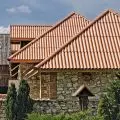There were to be dense office buildings, and there may be a green cultural forum. Work is starting on a plan for a very important part of Poznań. So there is a chance that the distinguished Polish Theater will get a unique setting. Its design should be chosen in a competition.
Sometimes it's worth not building and waiting, even if the delay concerns an acute spatial breach in the heart of the city. This is the case of the open area left by the tenements demolished after the war in front of the Polish Theater in Poznan. The site in question is the north side of 27 Grudnia Street between the iconic Okrąglak (1955, design: Marek Leykam) and the historic Arkadia building housing several cultural institutions, including the 8th Day Theater and the offices of the Malta Theater Festival.
27 Grudnia Street and Wolnosci Square in Poznań - on the left, the area in front of Teatr Polski between Okrąglak and Arkadia
source: openstreetmap.org
This Tuesday (November 12), Poznań councilors decided to start work on a new local plan for the area - replacing a heavily outdated document from 2002. This is necessary, because over these two decades the ownership relations here have changed, as well as the thinking about the area in front of the Theater: from the ideas of restoring the frontage along the pre-war building line, through slightly less intensive investment variants, to the fairly widespread agreement on the green and open character of the space supplemented by smaller cubicles.
27 Grudnia Street in Poznań - Polish Theater
photo: Jakub Głaz
This consensus resounded during two discussions arranged at the Polish Theater this year (in June and September). The debates, initiated and organized by the theater (and led by the undersigned), concerned the renovation and modernization of the facility, which will turn 150 years old in a year's time (reconstruction project: TOYA Design). Also discussed extensively was the development of the area in front of this oldest and distinguished stage in the city (the first Polish theater in the city built with contributions from residents).
27 Grudnia Street in Poznan - area in front of the theater, view from 3 Maja Street from under Arkadia, visible parking lot by the blind walls of tenement houses, behind it - the Theater, in front - Okrąglak, on the left - 27 Grudnia Street
photo: Jakub Głaz
plane trees as frontage
Where did the spatial breach come from? The war contributed to it only partially. Until 1945, a compact frontage of tenement houses stood on a rather narrow (for the downtown area) street. During the fighting for the city, part of it was damaged and demolished soon after.
27 Grudnia Street in Poznan during the occupation, view from the west - the frontage on the left side does not exist, in place of the bank today stands Okrąglak
Source: poznan.fandom.com/wiki/Ulica_27_Grudnia
Thus, in the 1940s, two buildings on the ends of the frontage disappeared, and one - in front of the Polish Theater, which stands in the background. The latter was a magnificent tenement by Zygmunt Gorgolewski. It was erected in 1892, and the income from its lease fed the Polish stage (contrary to postwar urban legends about Germans who covered the theater with it as part of the Kulturkampf). A two-bay gate led to the courtyard in front of the Theater. The demolition of the building exposed the Theater. It soon gained architectural competition. A few parcels away, on the site of a former bank at the junction with Gwarna Street, the Okrąglak department store (now an office building) mentioned here was built.
Gorgolewski's tenement house in front of the Polish Theater in Poznan (1892), design
source: State Archive in Poznań
The rest of the houses of the northern frontage survived until 1977, when they were demolished preparing the ground for modern development in accordance with the plan of modernist reconstruction of the center. It was implemented successively from the early 1960s, but at the end of the next decade the economic crisis stopped any investment.
Plans for modernization of the center of Poznań from the 1960s - the area in front of the Theater in the background, to the right of Okrąglak (the unrealized skyscraper next to Arkadia is visible)
Source: Piotr Marciniak, "Experiences of Modernism. Architecture and Urban Planning of Poznań during the People's Republic of Poland".
A spatial hole, converted in part into parking lots, began to gnaw at the historic space. Next to the exposed façade of the theater, the exposed blind walls of the tenements on 3 Maja Street were frightening. So in the early 1980s, the city decided to temporarily civilize this space according to the concept of Piotr Wędrychowicz. Two rows of plane trees were then planted on both sides of the sidewalk , which have grown to the present day in such a way that they form a kind of compact green frontage.
27 Grudnia Street in Poznan - view from the west, new sidewalk along the area of plane trees and tetrenium in front of the theater (June 2024)
photo: Jakub Głaz
27 Grudnia Street in Poznan - the area in front of the theater as seen from the intersection of 3 Maja Street and 27 Grudnia Street, the blind walls of the tenements with the CONSTITUTION mural are visible,
photo: Jakub Glaz
a lot of trying on for nothing
As the trees grew, the area was not developed - despite many covenants (changes in the street space can be traced here). Neither as a result of an urban planning competition in 1986, nor at the turn of the century, when a striking postmodern development concept was created, nor in the first decade of this century, when a private investor tried on the project with a concept by JEMS Architects. Neither did the office development, which was total in spirit, materialize, according to a 2015 project by Poznań-based Studio ADS.
27 Grudnia Street in Poznań - development concept from 2007 by JEMS Architekci.
© JEMS Architekci
Ownership issues stood in the way all the time: the site was a patchwork of private and city land. So for a long time the city tried to sell its plots and hoped for a wealthy investor to complete the development. In the second half of the decades, however, it changed its strategy and bought the land from private owners (except for one - between Okrąglak and the Theater). In this sensible way it gained the ability to freely decide on the entire space between Polski and Arcadia.
During this year's debate at the Theater, Deputy Mayor Mariusz Wisniewski dismissed rumors about the City's attempts to sell the land. In turn, representatives of the City ' s Urban Planning Studio announced work on a new plan. This is because the old document from 2002 is highly imprecise, allowing intensive frontage development and forcing the construction of an underground parking garage under the entire site. Currently, the creation of such garages is impossible after the reconstruction of 27 Grudnia Street as part of the Center Project [cf. extensive coverage and evaluation of these activities in The Center of Poznań after the revolution]. It is also unwarranted, given the magistrate's slow-moving policy of traffic calming in the downtown area.
27 Grudnia Street in Poznan - area in front of the theater on the left, in front - Arcadia
photo: Jakub Głaz
a green amphitheater?
In addition to planners, authorities and the management of Polskie, the open theater discussions were attended by residents - local and from other districts. Both groups spoke almost unanimously in favor of not intensively developing the area (dissenting opinions were in the minority). It should have integrative, recreational and cultural functions - complementing the theater's offer. Such a solution, by the way, has long been suggested by the theater's directors Maciej Nowak and Marcin Kowalski. They threw around the idea as early as 2016, showing a sketch concept by the Trabendo studio showing a sunken green amphitheater.
The area in front of the Polish Theater in Poznan - sketch concept of a green theater forum by Trabendo studio (2016), the visualization was created as a starting point for discussion
© Trabendo
However, decision-makers at the time were pushing for a cubicle development. Today - and this resounded during the debates - they look much more favorably on the creation of a green theater forum supplemented with the new cubic capacity needed by the theater and as yet undefined solids or forms that will cover up the ugly blind walls (and become, for example, the city information center missing for Poznan, e.g. with a large-format model).
27 Grudnia Street in Poznań - view from the east, Okrąglak seen from the square in front of the Polish Theater (administrative wing and the stage in the former Malarnia - on the right), on the left: 27 Grudnia Street
photo: Jakub Głaz
A similar approach is taken by planners, for whom the three buildings flanking the space - Okrąglak, the Theater and Arkadia - are key in defining it. According to preliminary announcements, the plan's provisions will resonate with residents' expectations, which resounded during the discussion. Writing about the calling of the new plan, the City summarizes on its website the Study's provisions for the site (the plan area also includes the adjacent development quarter):
The direction of development will be multi-family residential or commercial development (...). Greenery (e.g., parks, squares), sports and recreation areas, as well as communication and technical infrastructure areas were adopted as supplementary directions of use. The study also indicates the need to create in this place a multifunctional urban space harmoniously combining elements of greenery and high quality downtown development, with permission to deviate from the restoration of its historic line.
27 Grudnia Street in Poznan - view from the west, from under Okrąglak, Polish Theater on the left, in front of it - parking lot on a private lot
photo: Jakub Glaz
prototype instead of a parking lot
The city also reports on a controversial provision, which says that under certain conditions the Study allows the location of retail facilities with a sales area of more than 2,000 sqm. During the discussion, planners reassured decision-makers that there are no plans to build a shopping mall or market. Instead, the goal of the plan is to prevent construction on the only private plot (its owner recently succeeded in court to invalidate the provisions of the old plan for his site). Reaching the pre-war building line, the development between the Theater and Okrąglak would derail plans for a coherent treatment of the area and obscure the Leykam icon.
27 Grudnia Street in Poznan - parking lots on the east side, Arkadia in the background, houses on the left at 27 Grudnia Street
photo: Jakub Glaz
During the discussion there were also calls to organize an architectural and urban planning competition in the future, and to quickly close the parking lot accessible from May 3 Street. According to the discussants, cultural events and prototyping of future spatial solutions for the area should be held there. All this in order to tame this space, which is unfrequented today, and thus conduct further participation with residents. It would also be worth thinking about an even broader concept for the downtown area. After all, the area in front of the theater, which belongs to the City, has a natural continuation in the form of the (also urban) Arcadia, Freedom Square and the Raczynski Library and National Museum located there . With skillful and forward-looking "programming," this entire space could become a lively urban cultural forum.























































































